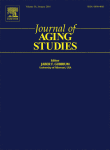Homelessness and Aging: The contradictory ordering of ‘house’ and ‘home’
The concepts of ‘house’ and ‘home’ are compelling and contradictory. They are compelling because they elicit the desired sentiments of permanence, feeling ‘at home’, and maintaining continuity in one’s life. At the same time, they can be experienced as contradictory where organizational practices and the socio-cultural imperatives of individual responsibility, cost containment, and rationed services are concerned. Where ‘house’ tends to evoke a sense of permanent stability, ‘home’ is regarded as the ideal living environment and site of care for older people. Yet, a consideration of the challenges that occur at the intersections of age and homelessness highlights a tension between the taken-for-granted ideal of ‘home’ for older people, and programs organized around ‘housing’ for homeless people. To begin, we ground our work in a critical perspective to the study of aging and briefly sketch the state of knowledge on homelessness in late life. We then explore the contradictions that occur at the intersections of age and homelessness, including the discursive ordering of ‘house’ and ‘home,’ the configurations of access and barriers, and aging in undesirable locations. In our conclusion, we draw attention to inequalities and the need for a life course perspective to ground future thinking. Our conceptual discussion is based on insights gained from a 3-year project on older homelessness in Montreal, Canada.

